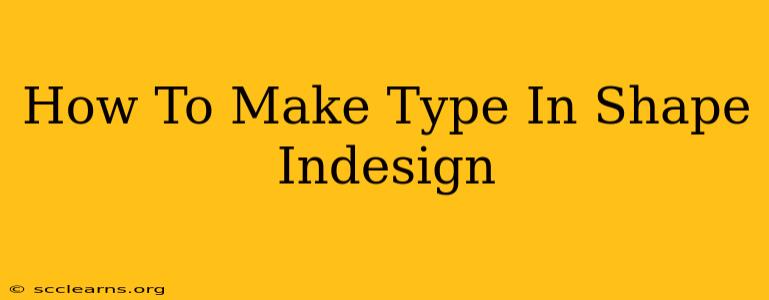Creating text that conforms to the shape of an object in InDesign is a powerful way to add visual interest and sophistication to your designs. This technique, often referred to as type on a path or type on a shape, is surprisingly easy once you understand the basic steps. This guide will walk you through the process, covering various scenarios and providing tips for optimal results.
Understanding the Fundamentals
Before diving in, it's crucial to grasp the core concept. InDesign allows you to flow text along any path, whether it's a simple circle, a complex curve, or even a custom-drawn shape. This differs from simply wrapping text around a rectangular frame; type on a shape allows the text to conform to the exact curves and contours of the shape.
Key Tools and Techniques
The primary tool you'll be using is the Type tool (T). However, you'll also need to create the shape first, using tools like the Rectangle Frame Tool (F), Ellipse Frame Tool (L), Polygon Tool, or the Pen Tool (P) for more intricate designs.
Step-by-Step Guide: Creating Type on a Shape
Let's create text that follows the outline of a circle:
- Create Your Shape: Use the Ellipse Frame Tool (L) to draw a circle on your InDesign page. Adjust its size as needed. Ensure your shape is a frame and not just a filled shape for optimal results.
- Select the Type on a Path Tool: This tool is usually located within the Type tool fly-out menu (click and hold the Type tool icon). It looks like a small 'T' next to a curved line.
- Click on the Shape's Path: With the Type on a Path tool selected, click directly on the path of the circle you created. This will create a text box that follows the curve.
- Start Typing: Begin typing your text. You'll notice it wraps around the circular path.
- Adjusting Text Flow: You can adjust the text's position along the path by clicking and dragging the text within the shape's path. Experiment with different text sizes and fonts to achieve the desired aesthetic.
- Formatting Options: Once you have the text on the path, you can further format it just like any other text box using character and paragraph styles in the Character and Paragraph panels.
Advanced Techniques and Troubleshooting
Working with Complex Shapes
The same principle applies to more complex shapes created with the Pen Tool (P) or other tools. The more precise your shape, the more precise the text wrapping will be.
Handling Text Overflow
If your text exceeds the length of the path, it will simply overflow. You can adjust the text size, font, or the shape's size to accommodate the content. In some cases, you might need to break the text into multiple segments on different paths or shapes.
Controlling Text Orientation
By default, the text usually follows the shape's path. However, you may sometimes need to adjust the orientation of the text. Experiment by dragging the text path and see how it affects the overall result.
Using Different Fonts and Styles
Experimentation is key! Try using different fonts and styles. Serif fonts often work well with smoother curves, while sans-serif fonts tend to be more effective on sharper shapes.
Optimizing for Readability
While visually appealing, always prioritize readability. Using overly complex shapes or tiny fonts can hinder the legibility of the text. Ensure sufficient contrast between the text color and the background shape.
By mastering the techniques outlined above, you can confidently incorporate type on a shape in InDesign to create striking and visually impressive designs. Remember that practice is key. Experiment with different shapes, fonts, and styles to develop your own unique approach.

